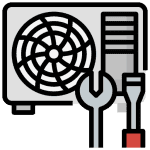When homeowners notice unusual ice formation or water issues with their cooling systems, two common culprits often emerge: problems with the ac condensate drain line and ice on air conditioner pipes. These issues can significantly impact system performance and require prompt attention to prevent costly damage.
What is an AC Condensate Drain Line?
The ac condensate drain line serves as a crucial component in every air conditioning system. This essential pathway removes excess moisture that naturally forms during the cooling process. When warm air passes over the evaporator coils, condensation occurs, and this water must be safely removed from the system through the drain line.
Modern HVAC systems typically feature an air conditioner drain line inside house configurations, allowing for convenient maintenance and monitoring. Understanding how this system works helps homeowners identify potential problems before they escalate into major repairs.
Common Issues with Condensate Drain Systems
Clogged Drain Lines
Over time, the ac condensate drain line can become blocked with debris, algae, or mineral deposits. When this happens, water backs up into the system, potentially causing water damage to surrounding areas. Regular maintenance helps prevent these blockages from occurring.
Frozen Condensate Lines
In colder climates, frozen condensate drain problems can develop when temperatures drop significantly. The water within the drain line can freeze, creating blockages that prevent proper drainage. This issue often requires professional intervention to resolve safely.
Understanding Ice on AC Pipe Outside Issues
Why Ice Forms on Air Conditioner Pipes
Ice on ac pipe outside formations typically indicate underlying system problems that require immediate attention. Several factors contribute to this concerning issue:
Restricted Airflow: When air filters become dirty or blocked, insufficient airflow over the evaporator coils causes them to become excessively cold, leading to ice formation on connected piping.
Low Refrigerant Levels: Inadequate refrigerant levels can cause the evaporator coils to freeze, extending ice formation to the surrounding pipes and connections.
Dirty Evaporator Coils: Accumulated dirt and debris on evaporator coils prevent proper heat exchange, resulting in temperature drops that promote ice formation.
Signs of Frozen AC Components
Homeowners should watch for several warning signs that indicate ice on air conditioner pipes or related freezing issues:
- Visible ice accumulation on exterior piping
- Reduced cooling performance
- Unusual sounds from the outdoor unit
- Water pooling around the indoor unit
- Higher than normal energy bills
The Connection Between Drain Lines and Ice Formation
The relationship between condensate drainage and ice formation creates a complex troubleshooting scenario. When an air conditioner drain line inside house becomes problematic, excess moisture can accumulate in areas where it shouldn’t, potentially contributing to freezing issues during temperature fluctuations.
Poor drainage can also indicate airflow problems that directly contribute to ice on air conditioner pipes. These interconnected issues often require comprehensive diagnosis to identify the root cause and implement effective solutions.
Prevention Strategies
Regular Maintenance Practices
Preventing both drain line clogs and pipe freezing requires consistent maintenance efforts:
Filter Replacement: Clean or replace air filters monthly to ensure proper airflow and prevent ice formation on system components.
Drain Line Cleaning: Schedule regular cleaning of the ac condensate drain line to prevent blockages and ensure proper water removal.
System Inspections: Annual professional inspections can identify potential problems before they lead to ice on ac pipe outside situations.
Seasonal Preparations
Different seasons require specific attention to prevent system problems:
Summer Preparations: Ensure drain lines are clear before peak cooling season to handle increased condensate production.
Winter Preparations: In colder climates, take steps to prevent freezing in condensate lines and protect exterior components.
Troubleshooting Steps for Homeowners
When You Notice Ice Formation
If ice on air conditioner pipes becomes apparent, take these immediate steps:
- Turn Off the System: Shut down the air conditioner to prevent further ice accumulation and potential damage.
- Allow Natural Thawing: Let the ice melt naturally without using external heat sources that could damage components.
- Check Air Filters: Inspect and replace dirty filters that may be restricting airflow.
- Examine Drain Lines: Look for obvious blockages in visible portions of the air conditioner drain line inside house areas.
Professional Intervention Requirements
Some situations require professional HVAC technician assistance:
- Persistent ice formation after basic troubleshooting
- Suspected refrigerant leaks
- Electrical component problems
- Complex drain line blockages
Long-term Solutions and Upgrades
System Improvements
Consider these upgrades to prevent recurring issues:
Enhanced Filtration: High-efficiency filters can improve airflow while capturing more contaminants that might otherwise clog drain lines.
Condensate Pumps: In situations where gravity drainage isn’t sufficient, condensate pumps ensure reliable water removal.
Insulation Upgrades: Proper insulation around vulnerable components can prevent ice formation during temperature extremes.
Smart Monitoring Systems
Modern HVAC technology offers monitoring solutions that can alert homeowners to developing problems before they become serious. These systems can detect changes in system performance that might indicate drain line issues or conditions leading to ice formation.
Cost Considerations
Understanding the financial implications of these problems helps homeowners make informed decisions:
Preventive Maintenance: Regular maintenance costs significantly less than emergency repairs or component replacement.
Energy Efficiency: Properly functioning drain systems and ice-free pipes ensure optimal energy efficiency and lower utility bills.
Property Protection: Addressing these issues promptly prevents water damage that can be far more expensive than the original HVAC problem.
Conclusion
Both ac condensate drain line problems and ice on ac pipe outside issues represent serious concerns that require prompt attention. By understanding the causes, implementing prevention strategies, and knowing when to seek professional help, homeowners can maintain efficient, reliable air conditioning systems year-round.
Regular maintenance, seasonal preparations, and prompt response to warning signs help ensure that air conditioner drain line inside house systems function properly while preventing costly ice-related damage. When in doubt, consulting with qualified HVAC professionals provides the expertise needed to resolve complex issues and maintain optimal system performance.


 Condenser Fan Motors
Condenser Fan Motors Blower Motor Wheels
Blower Motor Wheels Dryer Filters and Stainer Filters
Dryer Filters and Stainer Filters
 Copper Coils
Copper Coils Contactor
Contactor
 Compressor Oil
Compressor Oil

 Indoor/Outdoor Motors
Indoor/Outdoor Motors Out Door Fan Blades
Out Door Fan Blades Heating Elements
Heating Elements


 Vacuum Machine Parts
Vacuum Machine Parts Vacuum Pumps
Vacuum Pumps Thermostat
Thermostat
 Refrigerator Compressor
Refrigerator Compressor Split AC
Split AC




